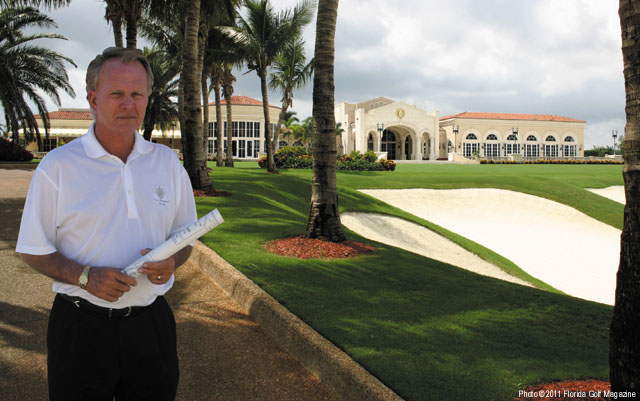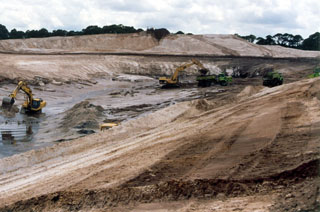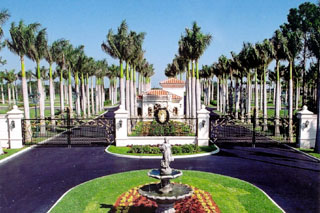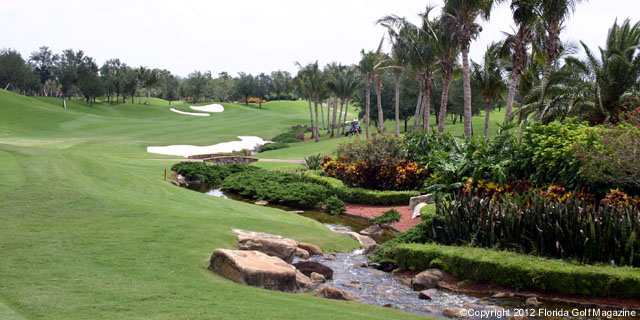
Golf Course
Architect Jim Fazio, seen here next to the 18th Green in front
of the Trump International Clubhouse.
In
a 2005 interview with Florida Golf Magazine, we asked Jim Fazio,
FGM: “How did you get the job designing the golf courses
at Trump International Golf Club?”
3 million
cubic yards of dirt were moved building the 1st 18 holes.
 “The
Trump Course Project started in 1997 and opened in 1999”,
said Jim Fazio. Donald Trump called me one day and introduced
himself and told me that a friend of mine had recommended me
to design a golf course for him in New York. He asked me if I
wanted to do it. And I told him, ‘sure I'll take a look
at it.’” “The
Trump Course Project started in 1997 and opened in 1999”,
said Jim Fazio. Donald Trump called me one day and introduced
himself and told me that a friend of mine had recommended me
to design a golf course for him in New York. He asked me if I
wanted to do it. And I told him, ‘sure I'll take a look
at it.’”
Jim elaborated,
“He then told me what he was thinking and what his wishes
were and I said well, ‘let me go see.’ So I went up
and looked at all of the land that he acquired. I came back,
did a plan and showed it to him.”
“He liked
the plan”, said Fazio. He asked me what I thought. I said,
‘Well, you have 16 really good holes and two 300 yard par
fours.’ I said, ‘You can't come up with a great golf
course with the first two holes being 300 yards.’ He asked,
‘What would you do?’ To which I said, ‘I would
go across the ravine there and buy that house and knock it down
and put the first hole and the second tee over there. Then you'd
have two great starting holes of 400 yards each. Then you’d
have a really great golf course.’”
“The land
originally had a golf course on it which we blew up. It was called
Briarcliffe Golf Club.” Jim continues, “he took it
over out of bankruptcy and ran it as a private club prior to
demolition. He used to play it every weekend, so he knew the
land very well. And, he knew there was a 100 feet deep ravine
there that a creek ran through, and he knew exactly what I was
talking about while I was speeking to him.
He called his
manager up and said, ‘go over and make an offer on that
house across from the golf course on the first hole. I want to
buy it.’ I'm listening to him do this while I'm still on
the phone. That was first time I witnessed the way Donald Trump
moves. Needless to say I was amused by it. To think that a guy
could just call up and say, go buy a million dollar house and
then tear it down and move part of the golf course over there.
Not many people are able to do that or would want to do that.”
“Trump then
said, ‘I'm just a little bit upset that I didn't think of
that instead of you.’ So he got the land and then also bought
the land next to it. So now we have 4 holes across the ravine.
It made the front nine so spectacular and hard that we had to
make it the back nine so people would have a chance to warm up
before playing it.” Jim Fazio then proudly said , “From
what I understand it got the highest slope and course rating
in the state of New York and many acolades for being one of the
best courses in the state.”
“I was back
in Florida while we were still in the permitting process in New
York, when I got another call from him. He said ‘I want
to build a course in Florida, in West Palm Beach. Would you be
interested in doing it?’ I said, sure I live here. I'm only
twenty minutes away. I could be there every day. He asked "what
would you do that no one else would do"? I said, I would
elevate it. I would raise it up in the air. Every Florida-style
golf hole has already been designed and built. I'll make it look
like it doesn't even belong in Florida. That must have done something
to him, because right on the phone he said, ‘OK you've got
the job’.”
During an interview
in 2004, Jim’s younger brother and competitor, golf course
architect Tom Fazio, told Florida Golf Magazine that the most
important feature of a potential golf course design project is
the Client. Tom Fazio said, “With today’s technology
we can move enough dirt to do almost anything, if the owner is
willing to spend the money.” This being said, it’s
plain to see that his big brother Jimmy won the proverbial jackpot
when Donald Trump decided he would be the lucky golf course architect
that got to design the course for the ultra private Trump International
Golf Club.
Trump International’s
driveway lined with Royal Palms
 Jim
Fazio then gave us some background information about the design
process of the course. Jim said, “The first time Donald
Trump discussed his plans for Trump International with me, he
told me ‘I want an elegant driveway to the clubhouse that
goes straight uphill so I can make it look like Royal Palm Way,
and I want a tough first hole. I want golfers to know where they
are when they come here, and what they are getting into.’” Jim
Fazio then gave us some background information about the design
process of the course. Jim said, “The first time Donald
Trump discussed his plans for Trump International with me, he
told me ‘I want an elegant driveway to the clubhouse that
goes straight uphill so I can make it look like Royal Palm Way,
and I want a tough first hole. I want golfers to know where they
are when they come here, and what they are getting into.’”
“The
first hole is very challenging, said Fazio. “It starts up
on a high teebox, and hits down on the fairway below you. It's
a 475 yard long slight dogleg right par 4. There's a creek that
runs along the right side of the tee, down the fairway past the
dogleg. The green sets uphill, so you have an uphill shot to
the green with the prevailing wind normally blowing in your face.
It's bordered
by trees on both sides so you are unable to see any other holes
from the tee. Due to the length, and because of the bunkers on
the left at the dogleg and the creek on the right, good players
will start by hitting over the right side of the fairway and
drawing the ball in. If they try taking it down the left side
and fading it, they risk hitting it in the bunkers, and then
they'd have a really hard shot. You can advance it out of the
bunkers, but probably couldn’t get it to the green from
there.

The 1st
Hole. 475
yards from the back tees, the par 4, #1 Hole, has a creek along
the right side of the entire length of the fairway. A drive to
the left sets up a long approach to an elevated green, protected
by a deep swale front and right.
It's
one of the hardest first holes that you'll find on any golf course
in the world. Starting holes are usually designed so you can
get warmed up, miss a shot and still make par or bogey. That
is not this golf hole by a long shot. The 1st hole at Trump International
could be the 18th hole at any golf course anywhere in the United
States due to the difficulty, but it's a great looking golf hole,
with the big oak trees on the left, coconut trees by the creek,
and you can hear the trickling of the water while standing on
the tee.”
Architect Jim
Fazio also explained for us how he took into account for wind
in the design strategy at TIGC. Jim told us, ”We designed
the hard holes against the favoring wind, so then when the wind
turned around we still had some holes that were deterred by that
wind, so it keeps the course balanced. Especially since all the
par 5 holes run in different directions. All our par 3 holes
also run in different directions. We also have a lot of uphill
shots and downhill shots. Trump International has a real variety,
it's not a typical Florida Golf Course. I think that's what make
it so unique and special.”
Regarding Mr.
Trump, Jim said, “It was so much fun to build this course
because the owner never asked, were we spending too much money.
He always asked, ‘Do you need anything else?’ Those
were his words every time he came out. Working for a guy like
that is fun, because he doesn't stifle the creative process.”
Mr. Fazio described
his ongoing work on the course. “Every year we'll tweak
the course here or there, but there's never any major changes
that we have to make. Maybe add a tree here or there, or widen
a bunker out, to narrow a fairway, but that’s about it.
We have all the ingredients here for a really great golf course.”

The 215
yard, par three #17 at Trump International Golf Club in West
Palm Beach, Florida.
“The
whole project,” Jim explained “which took over two
years to do, is probably the most fun I ever had building a golf
course. I never really thought about the pressure I was under
to build a great golf course. Using too much money never entered
my mind until a couple years after it was finished. Trump really
put me under the gun by giving me that much money and saying,
‘Give me the best that you can do’, and ‘how good
is it going to be?’”
Jim continued,
“My uncle, George Fazio, used to say ‘Never worry about
anything, just work through it and keep going.’ So we just
worked every hole, every angle and looked at it every day for
a solid year after we moved the dirt and the trees. So if there
were any changes to be made, we made them while we were there,
when it was easy to see it right away. As far as I'm concerned,
I don't know how it could have turned out any better. Nor do
I know how we could have spent any more money without it making
it look gaudy.”
“One of
the things that helped make this course so good was that we started
with a clean slate and were allowed to do almost anything we
wanted,” Jim cheerfully acknowledged. “After deciding
the routing, we moved over 3 million cubic yards of dirt using
a rough grading plan. We never did a final finish plan at the
start of the project, so the finishing features of every hole
were decided on, and built on the job as we went along. Designing
as we went along, deciding on one feature at a time, is what
made the golf holes so unique, because we could do anything we
wanted to them while we were building them. We weren't stuck
doing anything because of a finish plan.”
“we were
able to move so much dirt because Donald Trump was the owner,”
admits Jim. “It’s nice when the owner says, ‘Do
you need more dirt? Do you need more trees? Do you need more
pipe?’ He was willing to do anything it took to make this
a spectacular course. A lot of times I had to tell him, ‘no
we don't need any more of this, we don't need any more of that.
Too much of one thing may be too much.’”
“As a result,”
said Jim, “We have a blend of everything we needed. We have
rock features, water features and they flow throughout the whole
golf course so you’re never really surprised when you see
something else, because you saw a little taste of it on this
hole and another little bit of it on that hole. That's what really
makes a golf course blend and flow like this. There are no real
surprises, and also it all looks natural because of the hills
and slopes that we have.”
“We started
the job,” he continues, “and it took us one year just
to transplant 5,000 trees, move 3 million tons of dirt and build
the lake system. The Department of Environmental Resources (ERM)
told us we could only clear 50 acres at a time. It was sketched
out into seven sections. We had to go in and label all the trees
and move what we could. What we knocked down, we had to mitigate.
We also relocated over 60 Gopher Tortoises. It was a long drawn
out process, the longest one I've ever been involved in.”
“We started
building the golf course after that.” Jim explained. “I
was actually in charge of the shaping and finish grading on that
project. I was there every day with my son, Jim, who was operating
the dozer and doing the detailing after we got it roughed in.
Together, we actually built all the greens, bunkers and tees.
That's how that golf course was built, day by day.”
Jim Fazio was
enthusiastic as he described the day by day endeavor. He said,
“Then, we had to figure out where we were going to put all
the water features. One of the hardest parts was building the
water feature at #17. It took nine months and cost 2.5 million
dollars, with all the work we had to do around it, and on the
feature itself.”
“The next
hardest job was building the cart paths, trying to hide them
between mounds and getting the concrete trucks up these hills.
We had a special dozer we rented just to pull the concrete trucks
in and pull them out. The concrete we used had Chattahoochie
stone aggregate and was twice as expensive as normal concrete.
Plain old concrete wasn't good enough for Donald Trump.”
The trees are
magnificent on this course, and Jim gives us some background
about them. “We bought and moved 1,000 oak trees from out
near Lake Okeechobee. It took us five months to move them all
in. These were 20 to 40 ft. oak trees. They had to wrap them,
and they could only haul three of them at a time. The landscaper
would bring them in and drill a hole in them and pick them up
to place them. I would place each tree after the hole was shaped.
This way we got our tree lined fairways. We also stuck some trees
out in the corners for targets for shot angles and stuff like
that.”
This painstaking
work with the trees continued, as Jim explained, “Then we
bought more than a thousand royal palms to line the outside of
the property. We lined the driving range with them, and around
the clubhouse to give it that formal stately look. We didn't
use them on the golf course, because to me they don't look natural.
We also bought 1,000 coconut trees. Coconut trees go great on
the golf course. They hang over the lakes. They hang over the
tees. Things like that make it kind of neat. Like when you go
up the cart path on 17, you’re going through a coconut trail.”
Jim Fazio concedes,
“I know we spent 2 million dollars on the little plants
that give the place color. That's a lot of plants. There's so
much variety and color in the plants, lakes, streams, creeks
and waterfalls, people spend time taking pictures and forget
to play, simply because they've never seen anything like this
in Florida. The golf course by itself probably cost 8 million.
And the water features and the trees cost another 8 million.
I would say without the clubhouse we spent 25 million. I know
he (Donald Trump) always says everything cost 40 million, but
I'd guess it cost a little more than that.
|